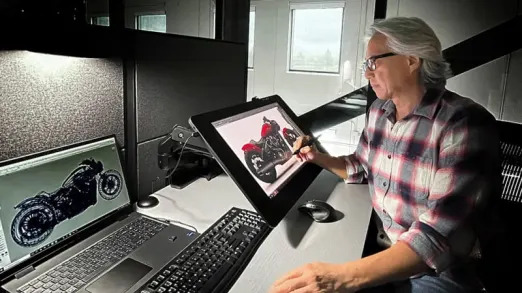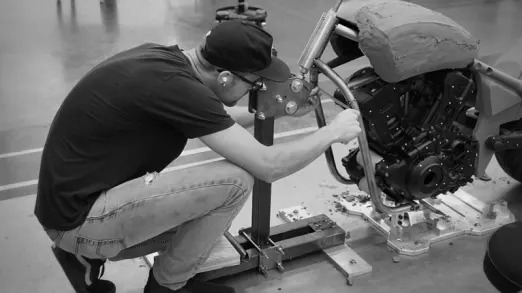All of it sounds so easy: A loping V-twin engine coddled tightly by body rails, mounted in between two suspended wheels and topped by a tank and, most often, a single saddle. The truth of the all-new 2025 Indian Scout, after all, is far more difficult. Autoblog not too long ago attended a digital introduction to the most recent motorbike from Indian, and we heard a whole lot of what you’d in all probability anticipate — particulars concerning the liquid-cooled 1,250cc SpeedPlus engine with as much as 111 horsepower and 82 pound-feet of torque, a compact metal tube body and plenty of speak concerning the want for a full line of equipment.
However what actually piqued our curiosity was when Ola Stenegard, director of product design for Indian Motorbike, centered our consideration on the artwork of turning design sketches into clay fashions. A decidedly old-school method, we thought. It seems Stenegard might speak for days concerning the artwork of bike design, and far of what he has to say traces its roots all the best way again to the famed designer Harley Earl.
“Using automotive clay was a really American factor. It began approach again within the ’20s truly, however I believe it acquired massive within the ’30s when Harley Earl went to Basic Motors,” Stenegard instructed us. “He introduced clay with him.”

And it seems the strategy of clay modeling “is definitely nonetheless the primary option to develop shapes within the automotive in addition to motorbike industries,” says Stenegard. “Lots of people assume that computer systems or AI have taken over, but it surely couldn’t be farther from the reality.”
It’s not that computer-aided design methods aren’t helpful, nevertheless. “Doing the small print, that’s the place CAD is superior,” Stenegard instructed us. “Badges, triple bushes, wheels. … Right this moment, these particulars — that’s the place we use the pc energy, the modeling.”
“Once I was nonetheless designing hands-on, we realized find out how to clay mannequin as a part of our schooling,” Stenegard instructed us. “However there’s a saying which you can’t be a very good sketcher and a very good clay modeler, and it’s true. The modelers are the fingers of the designer. There’s a symbiosis. We now have clay modelers, CAD modelers too. They’re phenomenal. They translate [design sketches] into actuality, and that’s essential to focus on.”


Simply as curiously, Stenegard and his group didn’t simply depend on old-school methods. They had been additionally impressed by traditional American automobile designs.
“That’s why the clay course of was essential — it enabled Detroit to discover a complete new period of surfacing,” stated Stenegard. “And for me, the American automobiles had been completely gorgeous. Have a look at the late-’30s Zephyr, or when you go into the top of the ’50s — a ’59 Cadillac — when you take a look at the surfacing, the fins, the small print, it’s simply phenomenal. Or with Lincoln, a ’64 or ’65 Lincoln, the slab-sided automobiles. To do the entire bodyside clear, there’s not one inch that’s flat or boring. It’s a clear automobile. In case you study that, it’s a superbly modeled floor, however there’s no edges.


“In order that was our inspiration. Hold it clear, maintain it easy. However to actually put the work into the surfacing, to make it lovely.
“The extra you simplify it, the tougher it will get. Doing a brilliant bike with a whole lot of edges and creases is nearly simpler than one thing clear and clear.”


